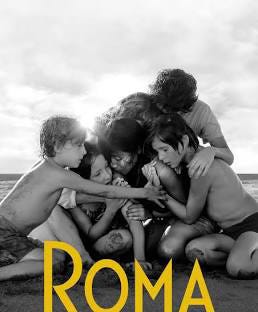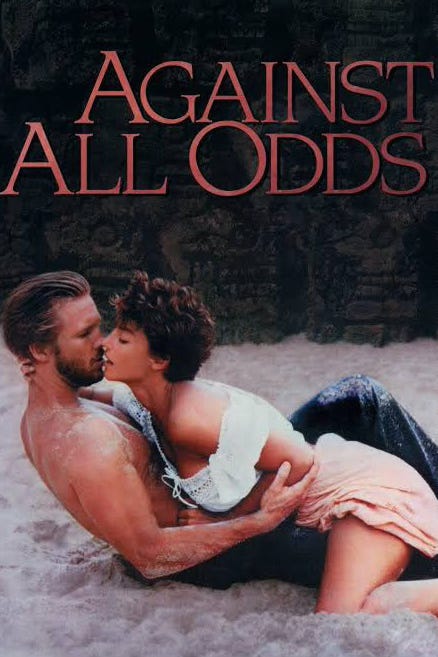Six Films that Define Mexico
Masterful movies shot in stunning locations, filled with emotion and meaning
Hola Amigos! In case I never mentioned it, I love movies. In this post I’m listing films that depict Mexico to me, due to the beauty of the screenplay, the film’s essence, or the overall film itself. Mexican movies convey such depth and emotion, often with better storylines than their US counterparts. Below is a combination of sub-titled movies and movies in English. With so many films to choose from, it was hard to limit to six.
Mexican films become more and more popular every year. With a wealth of creative and talented writers, directors and actors, they’re winning awards, and studios have stepped up worldwide distribution. While Mexican films are popular, so too are films made in the US about Mexico. Beginning in the 1940s with “Treasure of the Sierra Madre,” directed by John Huston and starring Humphrey Bogart, Mexico has grabbed hold of film-goers’ adventure-craving hearts. Here are some I’ve loved, with a short summary.
Roma
Filmed in monochrome, Alfonso Cuarón, Best Director Academy Awards, 2018, delivers an emotional portrait of domestic worker Cleo's journey set against the prevailing political and domestic violence in 1970s Mexico.
Titled "Roma" after the affluent Colonia Roma where Cuarón grew up, the director says though not totally autobiographical, it focuses on his childhood in Mexico City.
The film follows Cleo, a live-in maid, who works for a couple with four boisterous children and a live-in mother-in-law. It’s a houseful, even for the expansive upper-middle class setting we find ourselves in.
Trouble begins when the father leaves for a conference and never returns. Sofia, the mother, doesn't deal well with being left, and Cleo picks up a lot of the emotional baggage. It’s up to her to explain to the youngsters why dad didn't return.
Though the family, including parents Antonio and Sofia, love and welcome Cleo into their family, class lines are strictly in place. Occasionally they shower her with praise, but she is clearly hired help, quickly reminded of her position if she steps out of line.
Seen through Cleo's eyes, the film examines the class divide between races in Mexico. During a New Year's Eve fiesta in the countryside, the host's hired help indicate their dissatisfaction with the system, divulging how class truly does divide the country. It's Cleo's first view of outright dissension among workers.
"Roma" is set against the real life background of a country on the verge of political turmoil. Cuarón steps into the magnitude of it when Cleo and the mother-in-law are caught up in the Corpus Cristi massacre, a real event in 1971 where 120 people—mostly students—were murdered at a political demonstration. Mexico's president, Luis Ecchevería, had hired armed thug para-militaries, the Falcons, to beat back the students while police turned a blind eye.
In interviews, Cuarón says the story is based on many parts of his life and childhood. He dedicates the film to his real life nanny, Liboria Rodriguez.
The emotional final scene at the seashore will stay with you for a long time.
Traffic
At its core, “Traffic” focuses on three parallel stories interconnected by drugs. The story begins in Mexico with Benicio del Toro as a police officer entangled in a web of corruption involving high ranking officers and notorious drug traffickers. Across the border we meet Catherine Zeta-Jones, an affluent, pregnant San Diego housewife whose husband is arrested on charges of drug trafficking, leaving her to run the family business.
And across the country, Michael Douglas plays an Ohio judge appointed as new drug czar, unaware that his daughter is a coke addict.
The film is Steven Soderbergh's tenth, and a nod to his ability to brilliantly represent each character and their motives, be they user, enforcer, trafficker, lawyer, or politician. It's a statement on how drugs cross not only border lines but family, social, cultural, and political lines, tangling all into a web of deceit and corruption. Soderbergh won an Oscar for Best Director for the 2000 film.
Kicking off the story, del Toro and his partner stop a drug transport and arrest the couriers. The arrest is interrupted by Mexican General Salazar who wants del Toro to work for him and arrest a kingpin of one of the country's most powerful cartels. It becomes immediately clear that Salazar is corrupt and in the pocket of a cartel competitor, which leaves del Toro hanging. He drags in the DEA and the waters get murkier still.
In the US, a high stakes trial is set against Zeta-Jones' husband. She ups her game and prepares to assassinate anyone who plans to testify against her spouse. When sniper attempts fail, car bombs are employed. The viewer discovers that, in the jungle—any jungle—the female is more deadly than the male. As Zeta-Jones's husband is being placed behind bars, she crosses the border into Mexico to meet his suppliers. And the beat, and the family business, goes on, and on.
Y Tu Mamá También
Another film by Alfonso Cuarón, not unlike “Roma,” shows Mexico on the brink of a major political and cultural shift. In the story, three characters embark on an adventure—two teenage boys and a woman—a road trip. Julio and Tenoch— borderline adults, are always striving for the next best thing: girl, party, road trip. Searching these out becomes their manifesto
By sideline events occurring all around the characters, Cuarón gives us the lay of the land. It's the story of Mexico ten years into its early stretch of democracy, a young adult itself.
The clever parallel by the director, coming of age—awakening—isn’t only happening to Julio and Tenoch. It also unveils the coming of age of a country that’s ousting their long-standing political party that’s held the reins for 71 years, the PRI.
Along with his characters, “Cuarón gives as much importance to the background as to the foreground," said one reviewer. The director’s style is peppered with what appear to be off-camera scenes showing glimpses of the social environment.
These snippets are an eye-opener, showing how society and class in Mexico really work. The viewer is watching the scenes behind the scene, including the class differences between Julio and Tenoch. For Cuarón, the background is not something that is separate from the characters—it's an all encompassing force, a ‘character’ in itself.
When a politically-motivated riot happens and they hotfoot it out of town, the boys are still into their adolescent desires. The road trip becomes the message as they're joined by a runaway bride, Luisa, ten years their senior. The three share a united desire to reach a beach called Boca del Cielo, their Xanadu. Cuarón leads us and them to the ocean—for cleansing and rebirth.
But in narrator overviews, we're told how even the paradise they find with Luisa can be lost. The narrator describes the fate of a fisherman they meet at Boca.
"Fisherman Chùy will try to give tours to tourists but a collective of Acapulco boatmen who supported the local tourism board will block his plans. Two years later he will end up without a boat, as a janitor at a hotel. He'll never fish again."
In no uncertain terms, “Tu Mamá” is an exposé of how unbridled tourism along with corruption are bi-products of a system gone awry. Hand in hand, they ruin paradise.
It’s also a reminder of the brevity of youth—how one summer can change everything, turning adolescence into that stepping stone towards adulthood. Cuarón packs a lot into the movie. There’s a lot to digest.
In the end, when Luisa parts from the boys, she says, "Life is like the surf, so give yourself to the sea."
Against All Odds
Though “Against All Odds” may seem an unlikely choice for a film defining Mexico with opening scenes in Los Angeles, it quickly drives the storyline to spectacular Mexican locations in Yucatán and Quintana Roo—the island Cozumel, Cancun, Tulum, the Maya ruins overlooking the Caribbean, and the pyramids of Chichen Itza. Also prominently featured are the jungles of Yucatán.
Of note, this movie was the first time the Mexican government granted permission to use these sacred pyramid sites for filming. And they are stunning.
Jeff Bridges and Rachel Ward are both fugitives from the corrupt power and manipulation of the LA world, and for a brief moment, the virgin paradise of Mexico's jungles and pyramids offers them solace. The romantic other worldliness of the Yucatán provides a setting to find each other, something not possible in LA due to their respective "class differences and emotional baggage," said the director.
Bridges is a pro-footballer with a trick knee. In need of money, he’s contacted by an old acquaintance, James Woods, a shady night club owner, who needs to find his girlfriend, Jessie, who stole money from him and fled to Mexico. Though reluctant to take the job, Bridges needs the cash even though he knows Woods is untrustworthy.
Things go sideways when Bridges is contacted by the girl's mother, owner of his football team, who promises to double the sum Woods promised if he can find Jessie first and deliver her to the family, not Woods.
Bridges’ quest takes him first to Cozumel where he’s learned the girl is living (Isla Mujeres subs for Cozumel). He finds Jessie; she rebuffs him believing he was sent by her mother or her boyfriend. Bridges prepares to leave the island, but runs into Jessie who realizes he’s not trying to expose her. She invites him back to her jungle palapa and a passionate love affair begins.
Though the plot is a little complicated, the filming locations are worth the effort—Chichen Itza, Tulum, Isla Mujeres. Ultimately the plot works in the end, with Mexico as the true star of the movie. If you've never traveled to this jewel of a country, its beauty is on full display in"Against All Odds." It’s Mexico's at its very best. You may even book a ticket to experience it IRL. (We did. This movie was how we chose Mexico).
Amores Perros
Alejandro González Iñárritu’s gritty and fast-paced 2000 debut opens with a car crash in Mexico City that connects three separate tales and three social classes, all involving love and dogs, “Amores Perros.” As the film caught on with international audiences, that was translated to “Love is a Bitch.”
From gritty street scenes involving illicit, often violent, dog fights in poverty-stricken barrios to high-rise luxury apartments and modeling agencies, the pace doesn’t let up. Beginning with the working class, Octavio (Gael Garcia Bernal), is at the bottom rung of the poverty ladder. He resorts to entering his Mastiff in violent dog fights to earn money to whisk away his brother’s wife who he’s in love with. Part two is the story of a famous super-model who breaks her leg in the crash, and is having an affair with the married publisher of a magazine running her ads. Her dog’s antics horribly complicate the situation. And in part three, El Chivo (the Goat), a homeless person living on the city’s squalid outskirts, cares for his adopted mongrel dogs. A former teacher jailed for being a hitman for a political cause, he’s desperately trying to to make contact with his daughter who he abandoned due to his prison time. After the car crash and before help arrives, he steals Octavio’s dog fight money and takes the Mastiff, injured in the fight.
These disparate stories come together through the crash that starts the film off.
Man’s best friend, loyal as a dog, dog-eat-dog world—all parallel humanity on the streets of Mexico City.
It’s real life with all the complexities, long at two and a half hours. With González Iñárritu and his writer Guillermo Arriaga’s adept storytelling, it’s a phenomenal film that includes a morality primer. Their ability to weave these intricate sagas together in a meaningful way is an art form. If you’re queasy about animal cruelty (that the director strongly denies, stating it’s life in Mexico), which nearly derailed their entry into US markets and film competitions, I suggest watching a different film.
The Night of the Iguana
Puerto Vallarta will forever be linked to "The Night of the Iguana," filmed in Mimaloya, an out of the way beach ten minutes south and a mere fishing village at the time. Taken from Tennessee Williams’ 1963 play originally set in the US south, Williams' plot is less about Mexico and more about human nature—a tale of Baptist tourists stranded at a seedy hotel that just happens to be in Mexico. At the time of the filming in 1964, Puerto Vallarta was unknown, but "Iguana" changed that forever.
With Richard Burton as lead, the de-frocked man of the cloth seduces a young acolyte, Sue Lyon, on the tour bus. A scandal breaks and consequences are imminent. Though Burton is a draw in Mexico, he’s accompanied on location by his wife Elizabeth Taylor and she brings the paparazzi out in droves. Ava Gardener co-stars, and Sue Lyon, the ingenue, will eventually succumb to Burton's off-set wiles years later after he and Liz divorce. Of course Williams' plot line is intense and twisted. But the real showstopper, once again, is Mexico. “The Night of the Iguana” gave the movie world Mexico, and for that reason it will always be considered a “Mexico” film.
I’d love to know if you have a favorite Mexico film. Drop a line in the comments and let me know.
And if you’re interested in supporting independent journalism and writing, please consider a paid subscription to Mexico Soul. This is a free newsletter. I don’t paywall any of my posts, but you can choose to pay if you like what I deliver. It would mean the world to me and will keep you up to date on my posts and chapters from Where the Sky is Born—how we bought land and built a house in a small fishing village on the Mexico Caribbean coast. Not to mention a bookstore, too! All for $5/monthly or $50 per year.
If you enjoyed this article, please remember to hit the heart button to like it.
MY BACKSTORY—Puerto Morelos sits 100 miles from four major pyramid sites: Chichen Itza, Coba, Tulum and Ek Balam. Living in close proximity to this Maya wonderland made it easy to pyramid hop on our days off from Alma Libre Libros, the bookstore we founded in 1997. Owning a bookstore made it easy to order every possible book I could find on the Maya and their culture, the pyramids and the archeologists who dug at these sites and the scholars who wrote about them. I became a self-taught Mayaphile and eventually website publishers, Mexican newspapers and magazines, even guidebooks asked me to write for them about the Maya and Mexico. I’m still enthralled by the culture and history and glad there’s always new news emerging for me to report on right here on Mexico Soul.















It's a good selection of films, Jeanine.
I recommend these other Mexican films, for those who haven't seen them, which I think are terrific:
El Castillo de la Pureza de Arturo Ripstein
Canoa de Felipe Cazals
El Hombre de Papel de Ismael Rodríguez
Macario de Roberto Gavaldón
Los Olvidados de Luis Buñuel
La Ley de Herodes de Luis Estrada
Love this change of pace, Jeanine. Roma and Y tu mama are both in our top ten of all time and we have to add Alejandro Pelayo's Miroslava (he's a family friend)!